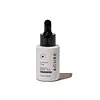What's inside
What's inside
 Key Ingredients
Key Ingredients

 Benefits
Benefits

 Concerns
Concerns

 Ingredients Side-by-side
Ingredients Side-by-side

Zinc Oxide 21.75%
Cosmetic ColorantDicaprylyl Carbonate
EmollientCaprylic/Capric Triglyceride
MaskingTridecyl Salicylate
Skin ConditioningButyloctyl Salicylate
Skin ConditioningCoco-Caprylate/Caprate
EmollientCoconut Alkanes
EmollientSorbitan Sesquioleate
EmulsifyingPolyglyceryl-2 Dipolyhydroxystearate
Skin ConditioningButyrospermum Parkii Butter
Skin ConditioningCetyl Alcohol
EmollientStearyl Alcohol
EmollientTocopheryl Acetate
AntioxidantCalendula Officinalis Flower Extract
MaskingOlea Europaea Fruit Oil
MaskingLecithin
EmollientEthylhexylglycerin
Skin ConditioningZinc Oxide 21.75%, Dicaprylyl Carbonate, Caprylic/Capric Triglyceride, Tridecyl Salicylate, Butyloctyl Salicylate, Coco-Caprylate/Caprate, Coconut Alkanes, Sorbitan Sesquioleate, Polyglyceryl-2 Dipolyhydroxystearate, Butyrospermum Parkii Butter, Cetyl Alcohol, Stearyl Alcohol, Tocopheryl Acetate, Calendula Officinalis Flower Extract, Olea Europaea Fruit Oil, Lecithin, Ethylhexylglycerin
Zinc Oxide 14.5%
Cosmetic ColorantBentonite
AbsorbentBisabolol
MaskingButyloctyl Salicylate
Skin ConditioningCalendula Officinalis Flower Extract
MaskingCaprylhydroxamic Acid
Caprylic/Capric Triglyceride
MaskingCaprylyl Glycol
EmollientCarthamus Tinctorius Seed Oil
MaskingCellulose Gum
Emulsion StabilisingCetearyl Alcohol
EmollientChamomilla Recutita Flower Extract
MaskingCoco-Glucoside
CleansingGlycerin
HumectantHelianthus Annuus Flower
Skin ConditioningJojoba Esters
EmollientMethyl Dihydroabietate
Microcrystalline Cellulose
AbsorbentNasturtium Officinale Flower/Leaf Extract
AntiseborrhoeicPolyhydroxystearic Acid
EmulsifyingPropanediol
SolventPueraria Lobata Root Extract
HumectantSpiraea Ulmaria Flower Extract
Skin ConditioningTetradecane
PerfumingTocopherol
AntioxidantWater
Skin ConditioningZinc Oxide 14.5%, Bentonite, Bisabolol, Butyloctyl Salicylate, Calendula Officinalis Flower Extract, Caprylhydroxamic Acid, Caprylic/Capric Triglyceride, Caprylyl Glycol, Carthamus Tinctorius Seed Oil, Cellulose Gum, Cetearyl Alcohol, Chamomilla Recutita Flower Extract, Coco-Glucoside, Glycerin, Helianthus Annuus Flower, Jojoba Esters, Methyl Dihydroabietate, Microcrystalline Cellulose, Nasturtium Officinale Flower/Leaf Extract, Polyhydroxystearic Acid, Propanediol, Pueraria Lobata Root Extract, Spiraea Ulmaria Flower Extract, Tetradecane, Tocopherol, Water
Ingredients Explained
These ingredients are found in both products.
Ingredients higher up in an ingredient list are typically present in a larger amount.
Butyloctyl Salicylate is a chemical UV filter structurally similar to octisalate. It is a photostabilizer, SPF booster, emollient and solvent. This ingredient helps evenly spread out ingredients.
According to a manufacturer, it is suitable for pairing with micro Titanium Dioxide, Zinc Oxide, and pigments.
Photostabilizers help stabilize UV-filters and prevents them from degrading quickly.
Learn more about Butyloctyl SalicylateCalendula Officinalis Flower Extract comes from the common Marigold plant. This ingredient is a skin conditioner.
Marigolds contain flavonoids. Flavonoids are a group of substances found naturally in plants. They possess antioxidant and inflammation properties.
This ingredient soothes skin inflammation by inhibiting inhibiting a part of the inflammation process.
Marigolds have been used in traditional medicine throughout Asia and Europe.
Learn more about Calendula Officinalis Flower ExtractThis ingredient is an emollient, solvent, and texture enhancer. It is considered a skin-softener by helping the skin prevent moisture loss.
It helps thicken a product's formula and makes it easier to spread by dissolving clumping compounds.
Caprylic Triglyceride is made by combining glycerin with coconut oil, forming a clear liquid.
While there is an assumption Caprylic Triglyceride can clog pores due to it being derived from coconut oil, there is no research supporting this.
Learn more about Caprylic/Capric TriglycerideZinc Oxide is a mineral broad-spectrum UV filter; it is the broadest UVA and UVB reflector approved by the FDA. It also has skin protectant and skin soothing properties.
Zinc oxide is one of the most effective broad-spectrum UV filters. It protects against UVB, UVAII, and UVAI. In comparison to its counterpart titanium dioxide, zinc oxide provides uniform and extended UVA protection.
Another great benefit? This ingredient is highly photostable so it won't degrade easily under sunlight.
A common myth is that mineral UV filters are widely believed to primarily reflect UV light.
However, modern research shows titanium dioxide absorbs UV radiation like chemical filters (~95% absorption & 5% reflection).
Zinc oxide has great skin soothing properties so you'll likely find this in sunscreens formulated for sensitive skin or babies/children. It is unlikely to cause "eye sting" like other sunscreen ingredients.
Regulatory agencies consider zinc oxide to be non-toxic and safe. It has also been shown to not penetrate the skin.
Unfortunately, this ingredient does leave a visible white cast. This is why mineral sunscreens are often less cosmetically elegant than chemical or hybrid ones.
In cosmetics, zinc oxide can be found in both non-nano and nano-sized forms. The nano version is used to reduce white cast and improve the texture of sunscreen formulas.
There are ongoing concerns surrounding nano-zinc oxide's impact on marine ecosystems and whether it can be absorbed into skin.
Regarding marine ecosystems and coral reefs, there is no conclusive evidence that any form of zinc oxide (or any other sunscreen ingredients) will cause harm. The science is still developing but many consumers are keeping a close eye on this issue.
Please note, many destinations have reef-safety sunscreen rules. For instance, the U.S. Virgin Islands advises all visitors to use non-nano mineral sunscreens.
There has also been some stir about whether micronized or nano zinc oxide has potential photoxicity and absorption through the skin/lungs.
An in-vitro (done in a test tube or petri dish) study demonstrated micronized zinc oxide to have potential phototoxicity. There's no need to fret; the EU Commission's Scientific Committee on Consumer Safety has stated, "The relevance of these findings needs to be clarified by appropriate investigations in vivo." Or in other words, further studies done on living organisms are needed to prove this.
Current research shows zinc oxide nanoparticles do not penetrate intact or sunburned skin. They either remain on the surface or in the outermost layer of dead skin (stratum corneum).
Zinc oxide is one of only two classified mineral UV filters with titanium dioxide being the other one.
Fun fact: Zinc has been used throughout history as an ingredient in paint and medicine. An Indian text from 500BC is believed to list zinc oxide as a salve for open wound. The Ancient Greek physician Dioscorides has also mentioned the use of zinc as an ointment in 1AD.
Learn more about Zinc Oxide